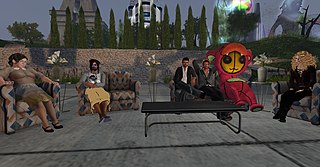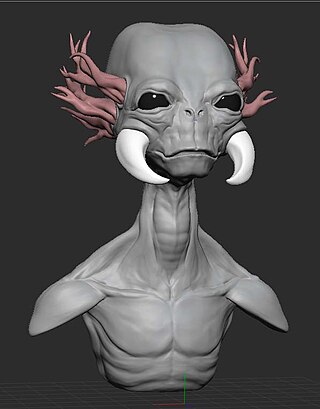
Virtual reality (VR) is a simulated experience that employs 3D near-eye displays and pose tracking to give the user an immersive feel of a virtual world. Applications of virtual reality include entertainment, education and business. VR is one of the key technologies in the reality-virtuality continuum. As such, it is different from other digital visualization solutions, such as augmented virtuality and augmented reality.
Autodesk 3ds Max, formerly 3D Studio and 3D Studio Max, is a professional 3D computer graphics program for making 3D animations, models, games and images. It is developed and produced by Autodesk Media and Entertainment. It has modeling capabilities and a flexible plugin architecture and must be used on the Microsoft Windows platform. It is frequently used by video game developers, many TV commercial studios, and architectural visualization studios. It is also used for movie effects and movie pre-visualization. 3ds Max features shaders, dynamic simulation, particle systems, radiosity, normal map creation and rendering, global illumination, a customizable user interface, and its own scripting language.

There is a 3D online virtual world created by Will Harvey and Jeffrey Ventrella. There Inc. was founded in the spring of 1998. Closed beta began in July 2001, with various stages of beta following, and ending with an October 2003 launch date. On March 9, 2010 - one week after the announcement of its closure on March 2, 2010 - There.com shut its doors to the public.

Second Life is an online multimedia platform that allows people to create an avatar for themselves and then interact with other users and user-created content within a multi-user online virtual world. Developed and owned by the San Francisco–based firm Linden Lab and launched on June 23, 2003, it saw rapid growth for some years and in 2013 it had approximately one million regular users. Growth eventually stabilized, and by the end of 2017 the active user count had declined to "between 800,000 and 900,000". In many ways, Second Life is similar to massively multiplayer online role-playing games; nevertheless, Linden Lab is emphatic that their creation is not a game: "There is no manufactured conflict, no set objective."

A virtual world is a computer-simulated environment which may be populated by many users who can create a personal avatar, and simultaneously and independently explore the virtual world, participate in its activities and communicate with others. These avatars can be textual, graphical representations, or live video avatars with auditory and touch sensations. Virtual worlds are closely related to mirror worlds.

In computing, an avatar is a graphical representation of a user, the user's character, or persona. Avatars can be two-dimensional icons in Internet forums and other online communities, where they are also known as profile pictures, userpics, or formerly picons. Alternatively, an avatar can take the form of a three-dimensional model, as used in online worlds and video games, or an imaginary character with no graphical appearance, as in text-based games or worlds such as MUDs.

The metaverse is a loosely defined term referring to virtual worlds in which users represented by avatars interact, usually in 3D and usually focused on social and economic connection.

Digital sculpting, also known as sculpt modeling or 3D sculpting, is the use of software that offers tools to push, pull, smooth, grab, pinch or otherwise manipulate a digital object as if it were made of a real-life substance such as clay.

Whirled is a virtual world website and video game created by Three Rings Design. Its Open Beta stage was announced at the Game Developers Conference in 2007. It makes use of Adobe Flash as an applet embedded into the website while also having pages of HTML and JavaScript in a sidebar to allow players to manage their friends list and browse various categories of user-generated content. The concept is comparable to the virtual worlds in the PlayStation 3 game Home and Second Life, while also incorporating aspects of feed-based social media sites like Facebook and Twitter. It pushes to make all content user-created, mainly with its approach to creative accessibility using Flash's affinity for 2D vector graphics and various web compatibilities to make it very simple for players to upload a wide variety of content using simple, conventional file formats. Some examples of this include uploading PNG files to create in-game objects, and MP3 files to create a music playlist for a player's room.

Blue Mars, a 3D massively multiplayer virtual world platform developed by Hawaii-based Avatar Reality, allows 3rd parties to create virtual worlds, MMOG games, simulations, shops, businesses, entertainment venues, clothing, custom avatars, furniture, virtual homes, and other items. It consists of four main parts: the client software, the Sandbox Editor SDK suite, the website, and the host servers. It is often compared to Second Life, since both are virtual social worlds allowing user-created content. According to Jim Sink, CEO of Avatar Reality, "Blue Mars was inspired by a vision of the future when the power to terraform whole worlds is within our grasp. The name Blue Mars represents possibility and hope."
iClone is a real-time 3D animation and rendering software program. Real-time playback is enabled by using a 3D videogame engine for instant on-screen rendering.

NearGlobal is a London, UK, based software developer and publisher of Near, a 3D city browser platform and virtual world technology that delivers survey-accurate models of real-world cities that users can explore and interact with from their computer. The Near software was released in December 2009 with a public beta version incorporating the key shopping districts of London's West End.
VenueGen is a browser-based web conferencing service created and marketed by The Venue Network. It is a 3D virtual meeting software that enables users to interact with each other using avatars. Users can host and attend meetings, conferences, and training with other colleagues and upload rich media into virtual meeting rooms for real-time collaboration.

A virtual dressing room is the online equivalent of an in-store changing room.
Metaversum GmbH was a Berlin-based startup company behind the 3D virtual world Twinity. The company was founded in July 2006, and was led by CEO Jochen Hummel, CMO Mirko Caspar and CTO Christian von Hardenberg. In 2010, the company had offices in Berlin, Kyiv and Singapore and employed around 80 people. In 2012, after problems and declining usage at Twinity, Metaversum was acquired by the internet company ExitReality.

vSide was an Internet-based 3D virtual world that was launched on May 15, 2006. The game is in its public beta phase. However, the game appears to have been discontinued as of 2021. Initially developed by American studio Doppelganger, Inc., a studio founded in 2004, the game was acquired in June 2009 by ExitReality, which is the owner and developer. Inside the game's universe, users are called vSiders and can interact with each other through social networking, celebrity entertainment, virtual boutique shopping and self-expression. Membership is free.

Digital Fashion is the visual representation of clothing built using computer technologies and 3D software. This industry is on the rise due to ethical awareness and uses of digital fashion technology such as artificial intelligence to create products with complex social and technical software.

VRChat is an online virtual world platform created by Graham Gaylor and Jesse Joudrey and operated by VRChat, Inc. The platform allows users to interact with others with user-created 3D avatars and worlds. VRChat is designed primarily for use with virtual reality headsets, being available for Microsoft Windows PCs and as a native app for Android-based headsets such as Meta Quest, Pico 4, and HTC Vive XR Elite. It is also usable without VR in a "desktop" mode designed for either a mouse and keyboard or gamepad, and in an Android app for touchscreen devices.
Sinespace is a free-to-play massively multiplayer online Unity 3D-based platform created and published by Sine Wave Entertainment. It enables users to create and sell 3D content and interact with others as 3D avatars. It was beta launched in November 2016 and teamed up with Unity to make its SDK available in the Unity Asset Store in March 2019. It supports Oculus Rift, HTC Vive and Windows Mixed Reality headsets, but is also accessible through PC, Mac, Linux, and Chrome web browsers.

NeosVR is a free-to-play, massively multiplayer online, virtual reality application created by Solirax. It was released for free on Microsoft Windows via Steam on May 4, 2018, with support for several VR headsets.















